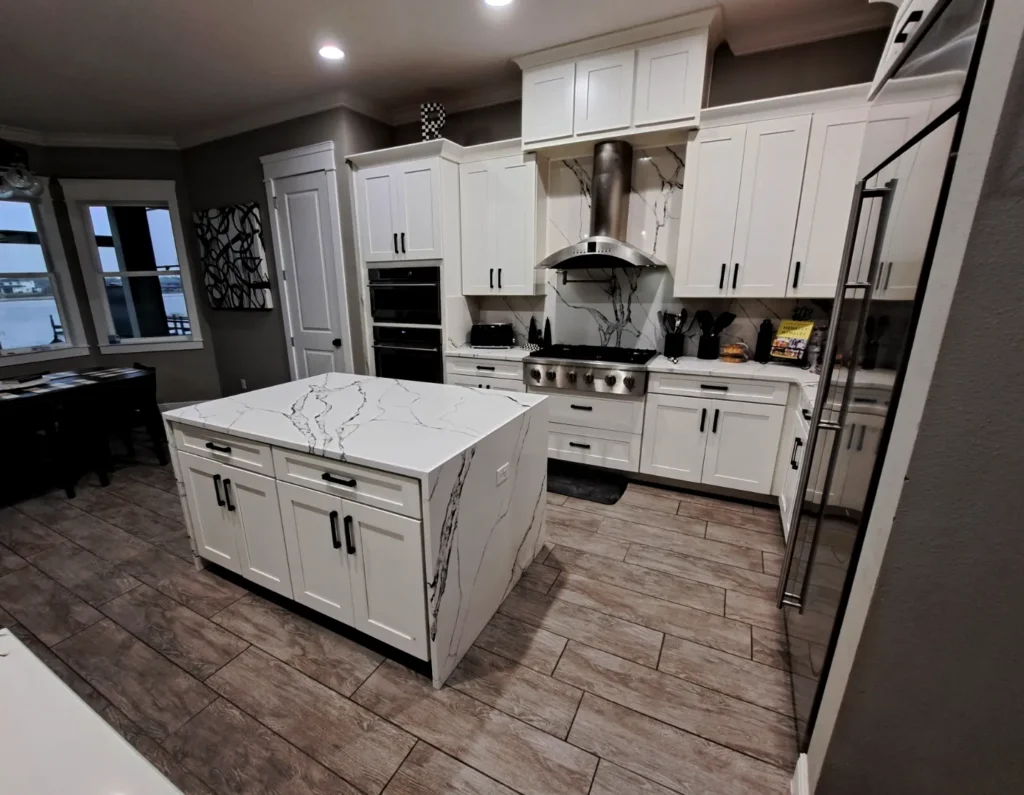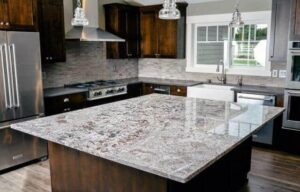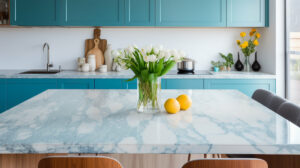The kitchen, so often the vibrant heart of the home, has evolved far beyond a purely utilitarian space. It’s a stage for culinary creativity, a hub for family gatherings, and increasingly, a powerful statement of personal style. In the pursuit of a kitchen that is both breathtakingly beautiful and deeply functional, a sophisticated trend has captured the imagination of discerning homeowners and designers alike: the artful mixing of countertop materials. This is particularly evident in the rise of the two-tone island, a design move that promises not just to elevate visual appeal but to significantly enhance project value and create those coveted, shareable moments on platforms like Pinterest and Instagram.
Forget the моноlithic expanses of yesteryear; today’s luxury lies in the nuanced interplay of textures, colours, and materials. A carefully considered combination – perhaps the cool, veined elegance of marble meeting the warm embrace of walnut, or the sleek modernity of quartz juxtaposed with the rugged charm of reclaimed wood – can transform an ordinary kitchen into an extraordinary one. This approach allows for a bespoke finish, reflecting a homeowner’s unique taste and lifestyle while also offering clever solutions for zoning and functionality. This guide will delve into the principles of mixing countertop materials like a seasoned professional, ensuring your kitchen makes a lasting, and doubly impactful, impression.

The Design Rules — Contrast vs. Complement: Finding Your Perfect Pairing
The decision to mix countertop materials is the first step; the next, and arguably most crucial, is determining your design philosophy. Will you opt for a bold, arresting contrast that commands attention, or a subtle, complementary scheme that whispers elegance? The answer lies in your overall vision for the space, the existing architectural elements, and the atmosphere you wish to cultivate.
The Power of Contrast
Opting for contrasting materials is a declaration of confidence, a way to inject drama and personality into the kitchen. This approach is particularly effective for:
- Defining Zones: A dark granite on the hardworking perimeter countertops, paired with a pale, striking quartzite on the island, clearly delineates cooking and preparation areas from the more social hub of the island.
- Creating a Focal Point: A show-stopping island topped with a dramatically veined marble against quieter, solid-surface perimeters ensures all eyes are drawn to the centrepiece.
- Adding Visual Depth: The juxtaposition of light and dark, or smooth and textured, prevents a kitchen from feeling flat or one-dimensional. Think of a sleek, black soapstone island base topped with a thick, rustic oak butcher block – the tactile and visual differences are immediately engaging.
Principles for Perfecting Contrast:
- Balance is Key: While the aim is to make a statement, one material should not completely overshadow the other. Consider an 70/30 or 60/40 split in visual dominance. For instance, if your island is the star in a vibrant Calacatta Gold marble, the perimeter counters might be a more subdued, matte black quartz.
- Proportional Harmony: The scale of your kitchen and its components will influence how much of each material to use. A smaller kitchen might benefit from a contrasting material on just a section of the island – perhaps a built-in butcher block cutting area – rather than the entire surface.
- Seamless Transitions: The point where two materials meet is critical. This junction should be intentional and flawlessly executed. Options include a clean, sharp line, a subtle waterfall edge where one material flows over the side, or even a slight change in height to demarcate zones, such as a raised bar area in a different material.
“When you embrace contrast, you’re essentially curating distinct experiences within the same space,” notes acclaimed interior designer, Alistair Finch. “It’s about brave choices that reflect how a kitchen is truly lived in – the robust, hardworking surfaces and the more precious, ‘showcase’ elements.”
The Subtlety of Complement
For those who prefer a more serene and cohesive aesthetic, a complementary approach offers a sophisticated, understated elegance. This strategy works beautifully when:
- Other Elements are Bold: If your cabinetry is a vibrant colour, or your backsplash is a statement mosaic, subtly coordinated countertops can provide a calming counterpoint.
- A Monochromatic or Tonal Look is Desired: A kitchen awash in varying shades of grey or white can be incredibly chic. Mixing two types of light-coloured quartz, one solid and one with soft veining, adds depth without disrupting the tranquil palette.
- Texture is the Star: Even with similar colours, playing with different finishes – a honed black granite perimeter with a leathered black granite island, for example – can create a rich, tactile experience.
Principles for Nailing Complements:
- Textural Dialogue: The magic often lies in the texture. A polished marble paired with a honed version of a similar stone, or a smooth engineered stone alongside a lightly textured one, adds interest that is felt as much as seen.
- Harmonious Patterns: If using materials with veining or particulate, ensure they don’t compete. A subtly veined quartz might pair beautifully with a micro-cement or a solid surface, whereas two heavily patterned stones could appear chaotic.
- Consider the Undertones: When working with neutrals, pay close attention to the undertones. A cool white marble might not sit as comfortably with a creamy, warm-toned quartz as it would with a cooler grey or a pure white.
Zone-Based Planning: Function Dictates Form
Beyond pure aesthetics, the most successful mixed-material kitchens are often designed with functionality at their core. This “zone-based” planning approach means selecting materials best suited to the tasks performed in specific areas:
- The Workhorse Zone: Areas around the sink and cooktop experience the most wear and tear. Durable, non-porous materials like quartz, granite, or stainless steel are excellent choices here.
- The Prep Station: A dedicated section of butcher block is a chef’s dream, offering a knife-friendly surface that can be sanded and re-oiled as needed. It also brings warmth to the space.
- The Baking Centre: Marble’s naturally cool surface is ideal for rolling out pastry. Incorporating a marble slab into a specific baking zone can be both practical and beautiful.
- The Social Hub: The island overhang, often used for casual dining or homework, might feature a more tactile or visually inviting material, like a warm wood or a beautifully patterned stone, encouraging guests and family to gather.
By thoughtfully considering contrast versus complement, and by aligning material choices with the functional zones of your kitchen, you lay the groundwork for a design that is not only visually stunning but also a joy to use every day.





